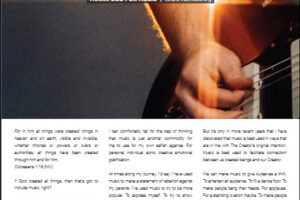Take this link to read Grant’s article as featured in the April issue of Worship…
M3 Video #31 – SOLVING DRUM VOLUME ISSUES: DYNAMIC CONTROL
By Grant Norsworthy
Due to such a positive response to the first video and its accompanying blogpost on this topic, I wanted to share even more!
Sure – acoustic drums that are too loud are a huge problem for many in Church music settings. But, in my opinion, the solutions that are utilized most often (shields, enclosures and electronic drums) are NOT the best ones. In fact, while they may “Band-Aid” one set of problems, they can create others.
The most fundamental way that drum volume can be controlled is at the very source: The drummer! It might seem too obvious, but drummers need to know how to hit their drums and cymbals with the appropriate amount of force. Too loud? Hit more softly! Of course!
Now, before any drummers throw their hands in the air exclaiming, “It’s not that simple!”, please stick with me. You’re right, it’s not that simple. Playing drums loudly is easier than playing drums softly. I get it – even though I’m not a drummer. Developing true, wide dynamic control is tough for drummers, but it is essential. Unfortunately, many drummers have never been told that … or they weren’t listening when they were.
And there are other issues too, like how the drums and cymbals sound when they are hit with less force. But that’s for another blogpost.
I am staggered by how many drummers – especially those in Church service settings – seem to have poor control over their own acoustic volume level and very little sense of what is the right volume for their drums in any given situation. And they often seem to have very little awareness of how loud they are in comparison to other instruments that make up the band’s sound.
A lot of Church drummers seem to operate within a dynamic range of about 6/10 up to about 10/10. Many are even narrower. Some can only play at 11! But most Church situations would be best served by a dynamic range that starts at 1/10 and only ever gets as high as, maybe, 7/10 – depending on the room, the type of drums and cymbals and the style of music.
The unconscious presumption by drummers can be that the audio engineer is taking care of how loud the drums are. But with drums being an acoustic instrument, in most small to moderately sized Church auditoriums (and even many larger ones) the audio engineer will have very little control over drums and cymbals that are being played too hard – even when they are shielded!
And so we see the most frequent “solutions” of shields or cages around the drums, or doing away with acoustic drums and cymbals all together and replacing them with an electronic kit that has a volume knob. These solutions may help or even solve the problem of drum volume. But at what cost?
Drummers behind sound barriers or playing electronic drums will have even LESS need to control their dynamics. They may play even harder! To say nothing of the awkward disconnection and “vibe-sucking” nature of the most common solutions, the drummers themselves are robbed of an opportunity to develop their hand control skills, their musicality, their ability to critically listen, and their sonic intuition. They will find it more difficult to play with volume that’s right for the song, and what is best going to encourage the congregation to sing songs of praise to Almighty God.
A drummer wearing in-ear monitors or headphones – which shields much of the actual, acoustic sound of their drums and allows them to adjust the level electronically – adds another layer to the barrier holding them back from the opportunity to develop dynamic control. But that’s for another blogpost too!
In this instructional video for Church music teams, Grant Norsworthy speaks with drummer Jonathan Truman about some of the pitfalls of the drum shield and how drummers can creatively exercise dynamic control – rendering the “fish tank” drum enclosure (with its significant negatives) totally unnecessary.
Jonathan also gives a wonderful, one take demonstration of the dynamic range available to a sufficiently skilled drummer who knows how to “play the room” as a higher priority than simply playing the drums.


